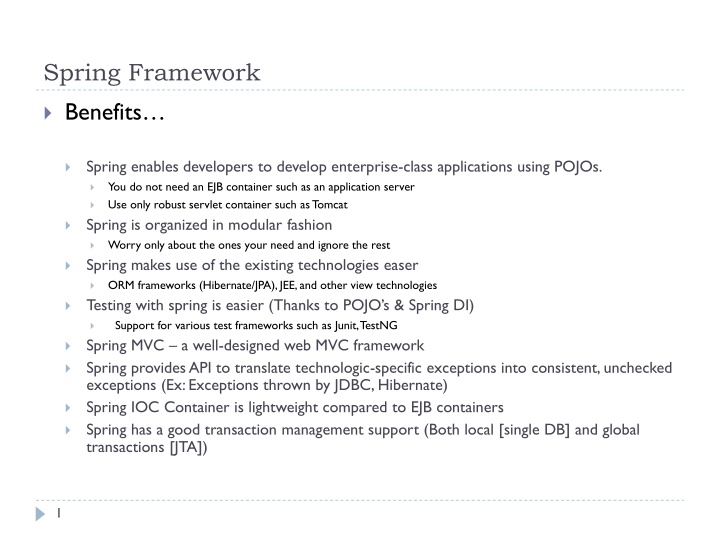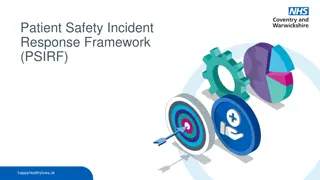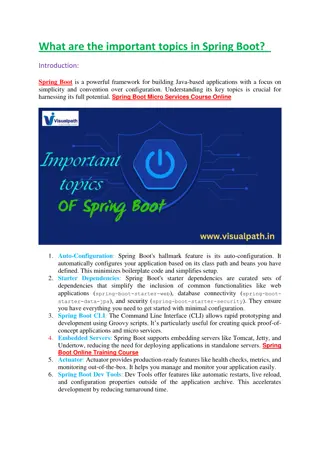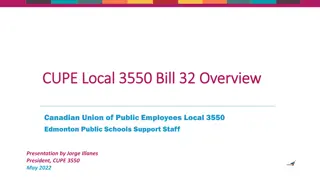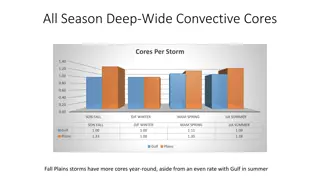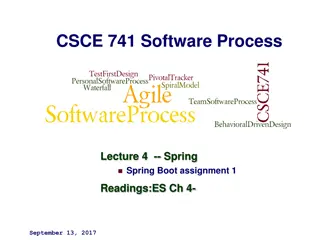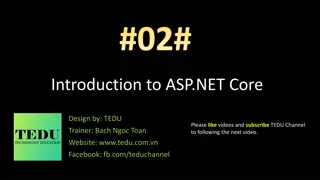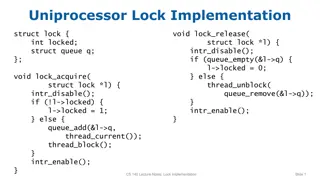Benefits and Core Features of Spring Framework
Spring Framework is a versatile technology that allows developers to create enterprise-class applications using Plain Old Java Objects (POJOs) without the need for an EJB container. It offers modular organization, seamless integration with existing technologies, easier testing capabilities, well-designed web MVC framework, lightweight IOC container, and robust transaction management support. Additionally, it simplifies bean life cycle management and provides support for bean post processors.
Download Presentation

Please find below an Image/Link to download the presentation.
The content on the website is provided AS IS for your information and personal use only. It may not be sold, licensed, or shared on other websites without obtaining consent from the author.If you encounter any issues during the download, it is possible that the publisher has removed the file from their server.
You are allowed to download the files provided on this website for personal or commercial use, subject to the condition that they are used lawfully. All files are the property of their respective owners.
The content on the website is provided AS IS for your information and personal use only. It may not be sold, licensed, or shared on other websites without obtaining consent from the author.
E N D
Presentation Transcript
Spring Framework Benefits Spring enables developers to develop enterprise-class applications using POJOs. You do not need an EJB container such as an application server Use only robust servlet container such as Tomcat Spring is organized in modular fashion Worry only about the ones your need and ignore the rest Spring makes use of the existing technologies easer ORM frameworks (Hibernate/JPA), JEE, and other view technologies Testing with spring is easier (Thanks to POJO s & Spring DI) Support for various test frameworks such as Junit, TestNG Spring MVC a well-designed web MVC framework Spring provides API to translate technologic-specific exceptions into consistent, unchecked exceptions (Ex: Exceptions thrown by JDBC, Hibernate) Spring IOC Container is lightweight compared to EJB containers Spring has a good transaction management support (Both local [single DB] and global transactions [JTA]) 1
Spring IOC Container The core of the spring framework. Create Objects Wire them together Configure them Manage their complete life cycle from creation till destruction 3
Spring Bean Life Cycle Initialization callbacks When a bean is instantiated (created), it may be required to perform some initialization to get it into a stable state When a bean is no longer required and is removed from the container, some cleanup may be required init-method / afterPropertiesSet() / @PostConstruct Method that is called on the bean immediately upon instantiation This method is called after the bean is created and its properties (if any) are set destroy-method / destroy() / @PreDestroy Method that is called just before the bean is removed from the container 4
Spring Bean Life Cycle Bean Post Processors The BeanPostProcessors operate on bean (or object) instances which means that the spring IoC container instantiates the bean instance and then BPP interfaces do their work. By default, Spring will not be aware of the @PostConstruct and @PreDestroy annotation. To enable it, you have to either register CommonAnnotationBeanPostProcessor or specify the <context:annotation-config /> in bean configuration file, 5
Spring Bean Life Cycle Bean Life Cycle Sequence Bean is created / instantiated Bean properties are set (Setter Injection) If (BPP) postProcessBeforeInitialization() If (init-method) init-method() If (BPP) postProcessAfterInitialization() Bean is ready Bean is getting destroyed If (destry-metod) destroy() 6
Spring AOP Inside XML Enabline @AspectJ Programming Module <aop:aspectj-autoproxy/> Define an Aspect Java Class @Aspect public class AspectModule { } Define the Aspect as a bean in XML <bean id="myAspect" class="org.xyz.AspectModule"> <!-- configure properties of aspect here as normal --> </bean> Declare a PONITCUT in the Aspect @Pointcut("execution(* com.xyz.myapp.service.*.*(..))") // expression private void businessService() {} // signature Declare an ADVICE in the Aspect @Around("businessService()") public void doAroundTask() { ... } @Before @After @AfterReturning @AfterThrowing @Around 7
Spring MVC Spring MVC is part of the Spring Framework as a MVC implementation The Spring Web model-view-controller (MVC) framework is designed around a DispatcherServlet that dispatches requests to handlers Open for extension . Closed for modification 8
The Dispatcher Servlet Spring MVC framework is request-driven, designed around a central Servlet that dispatches requests to controllers and offers other functionalities that facilitates the development of web applications Spring s DispatcherServlet is completely integrated with the Spring IoC container and as such allows you to use every other feature that Spring has DispatcherServlet is an expression of the Front Controller design pattern 9
src/main/webapp/WEB-INF/web.xml All incoming requests flow through a DispatcherServlet DispatcherServlet is an actual Servlet (it inherits from HttpServlet base class) and as such is declared in the web.xml file. You need to map requests that you want the DispatcherServlet to handle, by using a URL mapping in the same web.xml file 11
DispatcherServlets WebApplicationContext In Spring MVC each DispatcherServlet has its own WebApplicationContext. By default, spring always looks for the context at <dispatcherServletName-servlet.xml>. However this can be overridden with a Servlet init-param The DispatcherServlet related WebApplicationContext should have MVC-specific configurations such as Controllers, HandlerMappings, ViewResolvers etc , 12
ROOT WebApplicationContext Other non MVC-specific configuration such as the beans for service or persistence layer should be in root WebApplicationContext. In SpringMVC the root WebApplicationContext is bootstrapped by using ContextLoadListener specified as Listener in web.xml. So the DispatcherServlet WebApplicationContext will inherit (extend) from the ROOT WebApplicationContext 13
Handler Mappings HandlerMapping is the class that helps DispatcherServlet to map an incoming request to a particular Controller class. There are many HandlerMapping implementations in Spring, however the most used one is the annotated controllers HandlerMapping bean has one important property interceptors to which a user defined handler interceptor can be injected RequestMappingHandlerMapping This HandlerMapping implementation automatically looks for @RequestMapping annotations on all @Controller beans The RequestMappingHandlerMapping is the only place where a decision is made about which method should process the request <mvc:annotation-driven /> This annotation in the DispatcherServlet WebApplicationContext (file: /WEB-INF/classes/dispatcher-servlet.xml), will automatically register the RequestMappingHandlerMapping bean 15
WEB-INF/classes/dispatcher-servlet.xml Import any other context configuration files. For example to import the main ROOT application context file: <import resource="app-context.xml"/> Configure the @Controller programming model <mvc:annotation-driven /> Configure all the View Resolvers TilesViewResolver (and TilesConfigurer) JSPViewResolver MultiPartResolver ExceptionResolver CookieLocaleResolver 16
WEB-INF/classes/app-context.xml Initiate a component scan Configure a property place holder configurer Note that at run-time, these property files will typically be placed at: /WEB-INF/classes folder so they get detected in the classpath scanning 17
WEB-INF/classes/app-context.xml Property place holder configurer (This is a BeanFactroy PostProcessor) Sample Contents spring bean lifecycle callback method How to use 18
WEB-INF/classes/app-context.xml Configure Resource Bundle Message Resource (i18n) Note that at run-time, these properties files will typically be placed at: /WEB-INF/classes folder so they get detected in the classpath scanning The basenames property of the messageSource bean will by default look for files with the .properties extension. 19
WEB-INF/classes/app-context.xml i18n There should be multiple resource messages files one for each locale messages.properties Default and English messages_zh_CN.properties Chinese Sample Contents How to use (Say in JSP) We will use the Spring TagLib 20
WEB-INF/classes/app-context.xml Session Factory (Depends on DataSource) Spring support for hibernate LocalSessionFactory dataSource mappingLocations List of *.hbm.xml files hibernateProperties Such as show_sql, dialect etc , Other Service & Repository Beans (One example shown below) 21
View Resolver All the handler methods in the controller class must resolve to a logical view name explicitly by returning a String ViewResolver interface Provides a mapping between view names and the actual views There are many implementation is spring, but the prominent ones used are InternalResourceViewResolver and TilesViewResolver 22
InternalResourceViewResolver What s internal resource views? In Spring MVC or any web application, for good practice, it s always recommended to put the entire views or JSP files under WEB-INF folder, to protect it from direct access via manual entered URL. Those views under WEB-INF folder are named as internal resource views, as it s only accessible by the servlet or Spring s controllers class. In Spring MVC, InternalResourceViewResolveris used to resolve internal resource view (in simple, it s final output, jsp or html page) based on a predefined URL pattern. In additional, it allow you to add some predefined prefix or suffix to the view name (prefix + view name + suffix), and generate the final view page URL. If let s say controller returns a string carrierDetails ; the actual (physical) view it resolves to is /WEB-INF/jsp/carrierDetails.jsp 23
TilesViewResolver Resolves view names to protected .jsp resources within the /WEB-INF/jsp directory TilesConfigurer is input with configuration files that are located at /WEB-INF/tiles/*.xml 24
/WEB-INF/tiles/tiles.xml In tiles.xml we have defined a template base.definition This layout has a base template jsp = /WEB-INF/jsp/layout/layout.jsp in which attributes (as place holders) are defined. This layout contains attributes such as resources - /WEB-INF/jsp/layout/resources.jsp Header - /WEB-INF/jsp/layout/header.jsp appmenu - /WEB-INF/jsp/layout/appmenu.jsp body footer - /WEB-INF/jsp/layout/footer.jsp This layout is then extended and if required, the attributes are overridden /WEB-INF/jsp/layout/layout.jsp 25
/WEB-INF/tiles/industry-tiles.xml In industry-tiles.xml the base layout is extended for view carrier The body attribute is overridden with the actual JSP (listCarriers.jsp) which will render the view to populate with the Carrier Objects. Now from a Controller class, we return the logical view name which will not be a jsp name but rather a tiles definition name 26
Redirecting to views Redirect redirect: A Note on InternalResourceViewResolver Convenient subclass of UrlBasedViewResolver that supports InternalResourceView (in effect, Servlets and JSPs) and subclasses such as JstlView and TilesView. You can specify the view class for all views generated by this resolver by using setViewClass(..). If a view name is returned that has the prefix redirect:, the UrlBasedViewResolver (and all subclasses) will recognize this as a special indication that a redirect is needed. The rest of the view name will be treated as the redirect URL. In this example, the controller handler method does a delete operation and after this it is desirable that the user is presented back with the list of objects. So here the response is delegated to another controller method Here in this case, the list.do URL is called again by the client. 27
ExceptionResolver - Handling Exceptions in a generic way SimpleMappingExceptionResolver Takes the class name of any exception (ex: java.lang.Exception) that might be thrown from a handler method and map it to a view name. Map exception class names to view names Specify a default (fallback) error page for any exception not handled anywhere else Configuration annotation - @ExceptionHandler(Exception.class) Place this on the @Controller method(s) friendlyError.jsp 28
Implementing Controllers Controllers provide access to the application behavior that you typically define through a service interface Controllers interpret user input and transform it into a model that is represented to the user by the view In this example, the method is called for a URL /app-name/viewCarrier.do Call from a JSP: <a href="viewCarrier.do"><spring:message code='carrier.label' /></a> The methods takes Model as input parameter and return a Model and View Object The View is a string which is mapped either to a tiles definition name or an actual jsp file 30
@Controller The @Controller annotation indicates that a particular class serves the role of a controller Is a stereotype annotation extending from @Component. The DispatcherServlet scans such annotated classes for mapped methods and detects @RequestMapping annotations (see next slides) <context:component-scan base-package="com.tnsi" /> 31
@RequestMapping @RequestMapping is used to map URLs such as /viewCarrier.do onto a methods in the Controller class Can be used both at class level and methods levels Typically the class-level annotation maps a specific request path (or path pattern) onto a form controller, with additional method-level annotations narrowing the primary mapping for a specific HTTP method request method ("GET", "POST", etc.) or an HTTP request parameter condition. Spring 3.1+ The RequestMappingHandlerMapping is the only place where a decision is made about which method should process the request Think of controller methods as a collection of unique service endpoints with mappings for each method derived from type (class level) and method-level @RequestMapping information 32
Consumable Media Types You can narrow the primary mapping by specifying a list of consumable media types. The request will be matched only if the Content-Type request header matches the specified media type. For example: Note that in the above example, the request data is sent as part of the HTTP request body which is bind to the method parameter using the @RequestBody annotation 33
Producible Media Types You can narrow the primary mapping by specifying a list of producible media types. The request will be matched only if the Accept request header matches one of these values. Furthermore, use of the produces condition ensures the actual content type used to generate the response respects the media types specified in the produces condition. For example: Note that in the above example, the response data is sent back to the client as HTTP response (Not to a view) using the @ResponseBody annotation. Spring does the automatic conversion of the returned object to a HTTP Response to a format of JSON or XML Spring uses Jackson for JSON and JAXB for XML 34
URI Template Patterns - @PathVariable URI Template Is a URI-like string, containing one or more variable names http://www.example.com/users/{userId} variable name is userId When you substitute values for these variables, the template becomes a URI Assigning the value arun to the variable yields http://www.example.com/users/arun. Use the @PathVariable annotation on a method argument to bind it to the value of a URI template variable The URI Template " /owners/{ownerId}" specifies the variable name ownerId. When the controller handles this request, the value of ownerId is set to the value found in the appropriate part of the URI. For example, when a request comes in for /owners/arun, the value of ownerId is arun 35 This is the beginning of Spring RESTful services
@RequestParam Use the @RequestParam annotation to bind request parameters to a method parameter in your controller The above method can be invoked something like below: var actionUrl = "carrier.do?action=" + action + "&id=" + id; Note that the request params (action & id) are passed as part of the request URL Parameters using this annotation are required by default, but you can specify that a parameter is optional by setting @RequestParam's required attribute to false Type conversion is applied automatically if the target method parameter type is not String 36
@RequestBody The @RequestBody method parameter annotation indicates that a method parameter should be bound to the value of the HTTP request body. For example: HttpMessageConverter is responsible for converting from the HTTP request message to an object and converting from an object to the HTTP response body. The RequestMappingHandlerAdapter supports the @RequestBody (and @ResponseBody) annotations with the a set of default HttpMessageConverters The <mvc:annotation:driven /> configuration in the DispatcherServlet context configuration will enable the RequestMappingHandlerMapping and RequestMappingHandlerAdapter beans. 37
@ResponseBody This annotation can be put on a method and indicates that the return type should be written straight to the HTTP response body (and not placed in a Model, or interpreted as a view name). For example: The above example will result in the object SidCarrierInfo representation (Example: JSON, XML etc..,) being written to the HTTP response stream. As with @RequestBody, Spring converts the returned object to a response body by using an HttpMessageConverter. 38
@ModelAttribute An @ModelAttribute on a method argument indicates the argument should be retrieved from the model. For the object in the model, the argument s fields should be populated from all request parameters that have matching names. This is known as data binding in Spring MVC. This is usually used when the form-backing (or command) object is filled up and submitted from the client form. 39
@InitBinder Annotating controller methods with @InitBinder allows you to configure web data binding within your controllers @InitBinder identifies methods that initialize the WebDataBinder that will be used to populate command and form object arguments of annotated handler methods The following example demonstrates the use of @InitBinder to configure a CustomDateEditor for all java.util.Date form properties. It also sets the validator implementation to the binder (More on this later) 40
@Valid (JSR 303) In Spring, you can enable mvc:annotation-driven to support JSR303 bean validation via @Valid annotation on the handler method parameter, if any JSR303 validator framework is in the classpath Hibernate Validator is the RI for JSR303 On the model class, add hibernate validator annotations such as @NotNull, @NotEmpty, @Range, @Min, @Max etc , 0 to 9999 @Pattern (regex) Start with C or c Followed by exactly 4 digits 1 to 80 chars 41
@Valid (JSR 303) An @RequestBody method parameter can be annotated with @Valid, in which case it will be validated using the configured Validator instance. The validator was initialized using @InitBinder (from previous slides) Validator runs the validation code and based on PASS/FAIL, it sets the BindingResult BindingResult will now examined in the Controller as shown above for any errors 42
@Valid (JSR 303) JSP If there are any validation errors, they will be automatically bind to the model object On the JSP Page, using Spring custom tags, we can display the error messages: 43
@Valid (JSR 303) Error Messages There are default error messages that will be displayed for each of the JSR 303 validation annotations. This can be overridden in the message resources as key value pairs. Key is @annotationName.object.feildName objectname here refers to the command/model object name (reference) used in the JSP 44
References Theory http://docs.spring.io/spring/docs/3.0.x/reference/mvc.html http://docs.spring.io/spring/docs/2.5.6/reference/mvc.html Examples http://www.mkyong.com/tutorials/spring-mvc-tutorials/ 45
BACKUP Back Up Slides for Spring MVC 2.5.x 46
formView Create an instance of the form object (a.k.a command bean) Using the formBackingObject() method By default this method will return an instance of the class specified with setCommandClass() (remember commandName & commandClass properties?) formBackingObject() can be overridden to manipulate the form object before it enters the formView Creates the DataBinder and calls the initBinder() Override this method to register any custom PropertyEditors required when binding to the form object At this point, the view (formView) is ready to be rendered to the user. But before this referenceData() call-back method is called This life cycle method allows you to assemble and return any auxiliary objects required to render the view. The form object will automatically be sent to the view, so use this method to put anything else into the model the form page might need. 1. 2. 3. 48
Form Submission with the onSubmit() method Create an instance of the form object (a.k.a command bean) Using the formBackingObject() method Creates the DataBinder and calls the initBinder() Override this method to register any custom PropertyEditors required when binding to the form object With the form bean created , and the DataBinder created , the request parameters are now bound to the form bean Allow each configured validator (thru the validator property) to validate the form bean object After validation, the controller makes a decision based on whether any error exists If there are any errors display the original form view The referenceData() method is called once more to populate the model with object for the form. Finally, the form view is displayed again, with the errors and the form bean If no error exists Then the form bean can finally be processed in the onSubmit()method 1. 2. 3. 4. 49
Spring custom tags <spring:bind path= comamndName.attributeName > .... </spring:bind> <spring:bind path="carrier.carrierName"> <td><input name="<c:out value="${status.expression}"/>" value="<c:out value="${status.value}"/>" /></td> </spring:bind> The <spring:bind> tag extracts information about a single field ( carrierName" in this example) from the command object (named carrier" in this case) and places it in a status variable. ${status.expression} contains the name that the field should have and ${status.value} contains the value of the field (blank initially, but populated with previously submitted values if the form is redisplayed after submission errors). New Way <form:form commandName= carrier"> <td><form:input path= carrierName /></td> </form:form> The "comandName" attribute tells the form the name of the command object that contains our form data (specified in your form controller by calling setCommandName()) The "path" attribute gives the command object property that will be bound to the input field. Unlike the "path" attribute in <spring:bind> I didn't have to specify the command name here because the <form:form> tag already identifies the command object we'll binding to. 50
